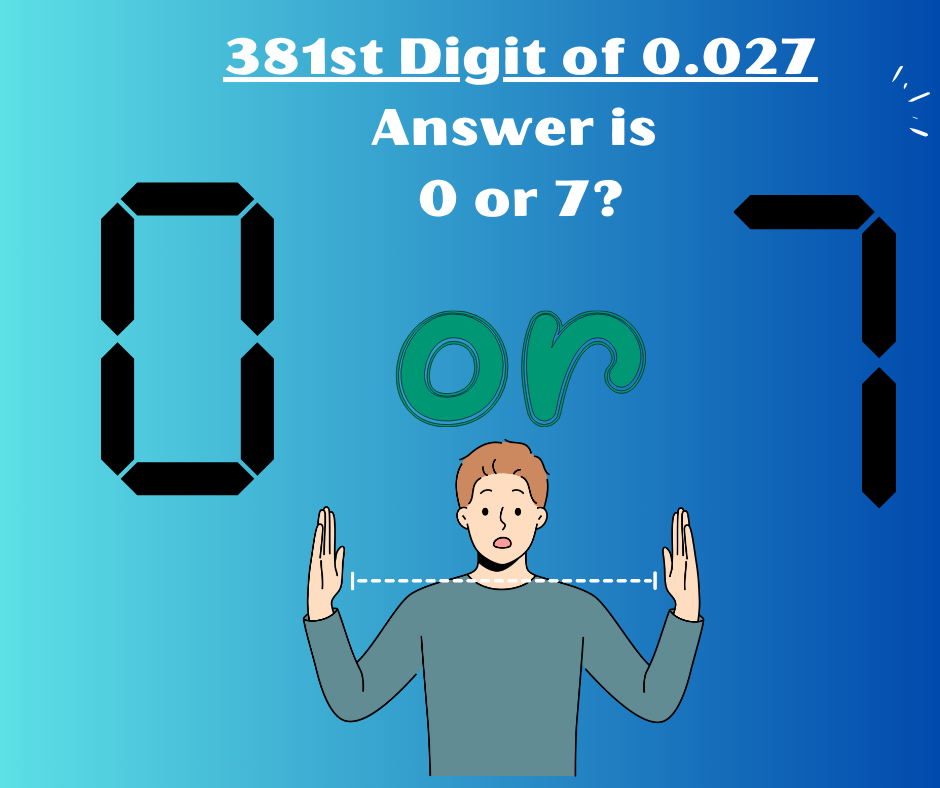381st Digit of 0.027: A Mathematical Mystery Solved
The 381st Digit of 0.027: A Closer Look
What is the 381st digit of 0.027?
- The 381st digit of 0.027 is 7.
The last digit in the repeating block 027 is 7.
2. Other snario is the 381st digit in the decimal expansion of 0.027 will be a 0, since all the digits after the third place are zeros.
So, whether you’re looking for the 10th digit, the 100th, or the 381st digit, the answer is always zero. To summarize:
- The 1st digit after the decimal is 0.
- The 2nd digit after the decimal is 2.
- The 3rd digit after the decimal is 7.
- The 4th digit and every digit after that, including the 381st, is 0.
Explain 381st digit of 0.027
There’s a misunderstanding.
The number 0.027 is a finite decimal. This means it has a limited number of digits after the decimal point. In this case, there are three digits: 0, 2, and 7.
Therefore, there is no 381st digit because the decimal representation of 0.027 ends after the 7.
If you were asking about a different number with an infinite decimal expansion (like π or √2), then we could discuss finding a specific digit. But for 0.027, the question is not applicable.
There’s a key point to clarify:
0.027 is a finite decimal. This means it has a limited number of digits after the decimal point (in this case, three: 0, 2, and 7). Therefore, there is no 381st digit because the decimal representation of 0.027 ends after the 7.
Understanding Finite Decimals and the 381st Digit of 0.027
In mathematics, a finite decimal is a number that has a limited number of digits after the decimal point. This is in contrast to infinite decimals, such as pi or the square root of 2, which have an endless sequence of digits.
The number 0.027 is a finite decimal. Its decimal representation consists of three digits: 0, 2, and 7. Since there are only three digits after the decimal point, there is no 381st digit in 0.027.
Key Points:
- Finite decimals have a limited number of digits after the decimal point.
- Infinite decimals have an endless sequence of digits.
- The number 0.027 is a finite decimal with three digits after the decimal point.
- There is no 381st digit in 0.027 because the decimal representation ends after the 7.
What is 381st digit of 0.027
To find the 381st digit of 0.027 when it is expressed as a decimal:
- First, observe that 027=2710000.027 = \frac{27}{1000}=100027, which terminates after three decimal places: 0.0270.027.
- Since 0270.027 is a terminating decimal, the digits beyond the third decimal place are all zeros.
- To find the 381st digit of 0.027, let’s first note that the decimal number 0.027 has only three digits after the decimal point: 0, 2, and 7.
- After these digits, the number continues with zeros. So, the 381st digit in the decimal expansion of 0.027 will be a 0, since all the digits after the third place are zeros.
The 381st Digit of 0.027: A Closer Look
At first glance, the decimal number 0.027 may seem like a simple number with just a few digits. You can easily read it as “twenty-seven thousandths” or 27 divided by 1,000. But what if you were asked to figure out the 381st digit in the decimal expansion of this number? This might sound confusing, but it’s actually an interesting exercise in understanding how decimals work.
Understanding Decimal Expansion
When we write a number like 0.027, we are looking at three specific digits after the decimal point: 0, 2, and 7. These three digits tell us how much smaller the number is compared to whole numbers. The decimal point separates the whole number part (which is zero in this case) from the fractional part.
- The digit 0 comes first after the decimal, representing zero-tenths.
- The digit 2 is in the hundredths place, representing two hundredths.
- The digit 7 is in the thousandths place, representing seven thousandths.
In mathematical terms, 0.027 can also be written as:
0.027=2710000.027 = \frac{27}{1000}0.027=100027
The Role of Zeros in Decimal Numbers
After the three digits 0, 2, and 7, something interesting happens. There are no more non-zero digits. From this point forward, if we were to continue writing out the decimal expansion, we would have an infinite number of zeros. This is because 0.027 is a terminating decimal—it has a finite number of non-zero digits, and after that, all digits are zeros.
So if we were to ask, “What is the 10th digit of 0.027?” or the 100th, or even the 381st, the answer would be the same: 0.
What Is the 381st Digit?
When dealing with a number like 0.027, once you pass the thousandths place, all remaining digits are zeros. So, whether you’re looking for the 10th digit, the 100th, or the 381st digit, the answer is always zero. To summarize:
- The 1st digit after the decimal is 0.
- The 2nd digit after the decimal is 2.
- The 3rd digit after the decimal is 7.
- The 4th digit and every digit after that, including the 381st, is 0.
This occurs because, beyond the first three digits, the decimal continues as an infinite series of zeros. For example, we could write the number as 0.027000000000000000000… and so on, with an infinite trail of zeros.
Why Does This Happen?
In mathematics, terminating decimals like 0.027 have a limited number of non-zero digits. These types of numbers are the result of fractions with denominators that are powers of 10. In this case, 0.027 is the decimal equivalent of 27 divided by 1,000. Once we express the fraction as a decimal, there are no more non-zero digits after the thousandths place.
This contrasts with non-terminating decimals, which can have an infinite number of non-zero digits. For example, the decimal expansion of 1/3 is 0.3333…, continuing with an infinite number of 3s. But 0.027 is not like that. It stops after three digits, and the rest are zeros.
Real-Life Application of Decimals
Decimals are everywhere in real life, from money to measurements. When you look at the price of something that costs $0.99, you’re dealing with a decimal. The same goes for gas prices, interest rates, and even measurements like weight or distance. Understanding how decimals work, including the role of zeros after the last non-zero digit, helps in everyday tasks like balancing a budget, calculating discounts, or measuring ingredients in a recipe.
Decimals like 0.027 also show up in scientific measurements. Scientists often work with very small or very large numbers, and they use decimals to express these quantities. A number like 0.027 might represent something like the distance between two microscopic particles or the concentration of a chemical in a solution. In these cases, knowing that the number has only three significant digits (0, 2, and 7) is important because it affects the precision of the measurement.
Conclusion
The question of finding the 381st digit of 0.027 is not applicable because 0.027 is a finite decimal with only three digits after the decimal point. Understanding the concept of finite decimals helps clarify this and other related mathematical questions.
To answer the question, the 381st digit of 0.027 is 0. In fact, every digit after the third one in this number is zero because 0.027 is a terminating decimal. The decimal stops at the thousandths place, and from there on, the number continues with an infinite number of zeros.
This simple exercise is a great way to understand the structure of decimal numbers and how they work. Whether you are working with large numbers, small numbers, or fractions, knowing that terminating decimals like 0.027 have an infinite series of zeros after the last non-zero digit can help you in both math problems and real-world situations.
Share this content:


Post Comment